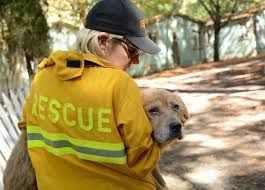Animal Evacuation

Your home and family have an evacuation plan, but what do you do for your pets and livestock? Follow these instructions from www.readyforwildfire.org/Animal-Evacuation/
LIVESTOCK
- Clear defensible space around your barns, pastures and property just as you do your home. PRC 4291 requires clearance around all structures on your property.
- Plan ahead, know where you would evacuate the animals Contact your local fairgrounds. stockyards equestrian centers, friends etc. about their policies and ability to take livestock temporarily in an emergency. Have several evacuation routes in mind. If you don’t have your own truck and trailer, make arrangements with local companies or neighbors before disaster strikes. Make sure your neighbor have your contact numbers (Cell phone, work, home, etc.).
- Have vaccination/ medical records, registration papers and photographs of your animals (proof of ownership) and your Disaster Preparedness Kit.
- If you must leave your animals, leave them in a preselected, cleared area. Leave enough hay for 48 to 72 hours. Do not rely on automatic watering systems. Power may be lost.
- Do not wait until the last minute to start evacuating!
Livestock Disaster Preparedness Kit
- Hay, feed and water for three days
- Non-nylon leads and halters
- First aid items
- Wire cutters and a sharp knife
- Hoof pick
- Leg wraps
- Shovel
- Water buckets
- Plastic trash barrel with a lid
- Portable radio and extra batteries
- Flashlights
During a wildland fire, local animal rescue organizations work with law enforcement and fire departments to rescue as many animals as they can. In battling a wildfire, firefighters will do what they can but they are not responsible for evacuating your livestock. Firefighters may cut fences or open gates to free trapped animals.
PETS
- Plan ahead. Know where you will take or leave your pets. In case you are not home when disaster strikes, arrange in advance for a neighbor to check on or transport your pets. Make sure your neighbors have your contact numbers (cell phone, work, home, etc.). In the event of evacuation pets may not be allowed inside human emergency shelters – have an alternate prearranged location to take your animals.
- Make sure your pets are always wearing properly fitted collars with personal identification, rabies and license tags.
- Each animal should have it’s own pet carrier. Birds, rodents and reptiles should be transported in cages. Cover cages with a light sheet or cloth to minimize their fear.
- Store vaccination/medical records, veterinary contact information, proof of owner- ship, a current photo, and a Disaster Preparedness Kit in one location.
Pet Disaster Preparedness Kit
- Pet carrier for each pet
- Two week supply of food and water
- Non-spill food and water bowls
- Pet first-aid kit
- Medications and dosing instructions
- Car litter box and litter
- Plastic bags for waste disposal
- Paper towels
- Disinfectants
- Leashes/collars/harnesses
- Blankets
- Toys and treats
- Newspaper
IF YOU MUST LEAVE YOUR PET
- If you must leave your pets, bring them indoors. Never leave pets chained outdoors!
- Use a room with no windows and adequate ventilation, such as a utility room, garage, bathroom, or other area that can be easily cleaned. Do not tie pets up!
- Leave only dry foods and fresh water in non-spill containers. If possible open a faucet to let water drip into a large container or partially fill a bathtub with water.